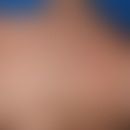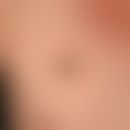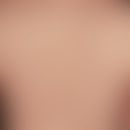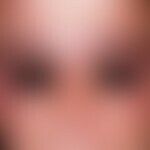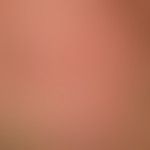Synonym(s)
HistoryThis section has been translated automatically.
Ayres 1930
DefinitionThis section has been translated automatically.
Rare chronic clinical picture with grouped, follicularly bound papules in saprophytic colonization of the sebaceous follicles with the approximately 0.03 cm large Demodex folliculorum and other Demodex species (e.g. Demodex brevis). Humans are the exclusive host for these parasites. However, the clinical picture is also known in veterinary medicine (e.g. in certain breeds of dogs). The occurrence of porcine demodicosis (Demodex phylloides) has been reported in Brazil (Bersano JG et al. 2016).
You might also be interested in
ManifestationThis section has been translated automatically.
Older adulthood (50-70 years)
Also in younger HIV-infected persons (30-40 years)
Occasionally also in immunocompetent adolescents and young adults
LocalizationThis section has been translated automatically.
Especially face, cheeks, eyelids, eyelid margins.
ClinicThis section has been translated automatically.
Chronic, usually unilateral, red, chronic plaques persisting for months with mostly disseminated, 0.1-0.2 cm large, follicular, red or red-brown nodules and pustules; often scaling and crust formation. With prolonged presence, reddening of the affected areas.
In rare cases, Demodex parasitosis on the face can lead to flat, reticular or follicular hyperpigmentation (pigmented demodicosis), which requires a differential diagnosis with lichen planus pigmentosus, melasma and post-inflammatory hyperpigmentation (Shencoru e et al. 2025).
Furunculoid nodules are less common, so that the clinical picture can be reminiscent of acne conglobata (demodex folliculits conglobata). Pityriasiform scaling of the affected areas.
Occasionally accompanied by itching.
Infestation of the eyelids(demodex blepharitis, infestation of the meibomian glands): Eyelid margin incrustations and eyelid margin eczema, photophobia and foreign body sensation.
The extent to which the frequent occurrence of the Demodex mite plays a role in the pathogenesis or exacerbation of rosacea is still unclear.
Demodex folliculitis in children is observed in acute lymphocytic leukemia.
HistologyThis section has been translated automatically.
3-5 or even more mites in a dilated follicle; perifollicularly arranged, inflammatory, partially epitheloid-cell infiltrate, spongiotic follicular epithelium; possibly perifollicular, granulomatous inflammation with rupture of the follicular epithelium.
DiagnosisThis section has been translated automatically.
Histology and clinic. Mites are very conspicuously detectable in the follicles in all stains!
For direct mite detection, a special horny layer tear-off with a cyanoacrylate fast adhesive is suitable. This is placed on a glass slide and immediately pressed onto the cheek skin. After a short time (60 seconds), the slide can be carefully unrolled. This pulls the follicle filaments with the mites out of the sebaceous gland openings. They can be assessed microscopically (Melnik B 2018).
An alternative would be confocal laser microscopy examination.
20 MHz sonography is also a suitable method to visualize follicular structures.
Differential diagnosisThis section has been translated automatically.
Bacterial folliculitis
Remember! In case of unilateral skin changes and if the response to "classic rosacea therapy" is poor, think of demodicosis!
General therapyThis section has been translated automatically.
External therapyThis section has been translated automatically.
Therapy with 10% Crotamiton emulsions (e.g. Eraxil Lotio). Treatment on 2 consecutive days, then 1 week treatment break, new treatment cycle.
Alternatively permethrin cream, benzyl benzoate (e.g. Antiscabiosum 10% emulsion), allethrin (e.g. Jacutin N spray) or ivermectin (1.0-2.0%) in a cream base (available as a ready-to-use product "Soolantra®").
Otherwise 1-2% metronidazole creams e.g. as a formulation - hydrophilic metronidazole cream, or gels (as a ready-to-use product e.g. Metrogel® or as a formulation - 2% hydrophilic metronidazole gel ) see also Rosacea.
- Mites can sometimes be expressed mechanically at the edge of the eyelid.
Remember! External glucocorticoid applications should be strictly avoided!
Internal therapyThis section has been translated automatically.
If local therapy is not sufficient, metronidazole (e.g. Clont 3x 250-300mg/day for 1-2 weeks - not helpful in all cases) can be used.
Alternative: therapy trial with doxycycline (e.g. Doxycycline Stada) 2 times/day 100 mg p.o.
Alternative: In the idea that retinoids can deprive the mites of their livelihood, isotretinoin (e.g. isotretinoin-ratiopharm; acne normin) should be discussed in severe cases. Dosage: Initial 0.5 mg/kg bw/day p.o., maintenance therapy 10-20 mg/day p.o.
Alternatively: Ivermectin 150-200 μg/kg KG p.o. as ED.
Case report(s)This section has been translated automatically.
42 year old Latin teacher has been noticing periocular localized inflammatory nodules for over 1/2 year. Little itching. Therapy resistance despite carefully performed therapy prescribed by the general practitioner. On inquiry also some glucocorticoid-containing ointments.
Findings: Periocular, red and reddish-brown follicular nodules, densified towards the eye and extending to the periphery. In some areas, the erythema is flat and not very scaly.
Histology: Perifollicular granuloma; several follicular mites detectable.
Therapy: Treatment with 10% Crotamiton emulsion 2 times/day. After 6 weeks complete healing of the lesions.
LiteratureThis section has been translated automatically.
Al Harbi SM et al.(2023) Facial Demodicosis-Induced Skin Hyperpigmentation in an Immunocompromised Man Treated Successfully with Ivermectin 1% Cream: A Case Report. Clin Cosmet Investig Dermatol16:1203-1207.
Baima B, Sticherling M et al. (2002) Demodicidosis revisited. Acta Derm Venereol 82: 3-6
- Bersano JG et al. (2016) Demodex phylloides infection in swine reared in a peri-urban family farm located on the outskirts of the Metropolitan Region of São Paulo, Brazil. Vet Parasitol 230: 67-73.
- Cotliar J et al. (2013) Demodex folliculitis mimicking acute graft-vs-host disease. JAMA Dermatol 149:1407-1409
- Forstinger C et al. (1999) Treatment of rosacea-like demodicidosis with oral ivermectin and topical permethrin cream. J Am Acad Dermatol 41: 775-777
- Forton F et al. (1993) Density of Demodex folliculorum in rosacea: a case-control study using standardized skin-surface biopsy. Br J Dermatol 128: 650-659
- Guerrero-González GA et al (2014) Crusted demodicosis in an immunocompetent pediatric patient. Case Rep Dermatol Med doi: 10.1155/2014/458046
- Jansen T et al (2001) Rosacea-like demodicidosis associated with acquired immunodeficiency syndrome. Br J Dermatol 144: 139-142
- Morras PG et al (2003) Rosacea-like demodicidosis in an immunocompromised child. Pediatr Dermatol 20: 28-30
- Melnik B et al (2018) Acne and rosacea. In: Braun-Falco`s Dermatology, Venereology Allergology G. Plewig et al. (Eds.) Springer Verlag S 1331
Shencoru E et al.(2025) Facial hyperpigmentation caused by pigmented demodicosis. J Dtsch Dermatol Ges 23:658-659.
- Vu JR et al (2011) Demodex folliculitis. J Pediatr Adolesc Gynecol 24:320-321
- Weingartner JS et al (2012) What is your diagnosis? Demodex folliculitis. Cutis. 90:65-66
- Yun SH et al (2013) Demodex folliculitis presenting as periocular vesiculopustular rash. Orbit 32:370-371
Incoming links (12)
Acne rosacea demodes; Demodex folliculorum; Demodicidosis; Demodicosis; Folliculitis superficial; Malasseziafolliculitis; Metronidazole cream hydrophilic 1/2% (nrf 11.91.); Metronidazole gel hydrophilic 0,75% (nrf 11.65.); Mites; Permethrin; ... Show allOutgoing links (17)
Acute lymphoblastic leukemia ; Demodex folliculorum; Folliculitis (overview); Isotretinoin; Ivermectin; Laser scanning microscopy; Metronidazole cream hydrophilic 1/2% (nrf 11.91.); Metronidazole gel hydrophilic 0,75% (nrf 11.65.); Papel; Perioral dermatitis; ... Show allDisclaimer
Please ask your physician for a reliable diagnosis. This website is only meant as a reference.
